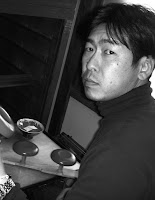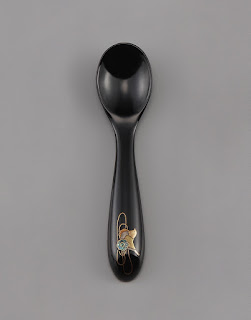Baby Spoons
When a devastating earthquake struck the Noto Peninsula in 2007, a number of lacquerware workshops were badly affected. Stock was damaged, equipment was broken and in some cases workshops and storehouses collapsed. It was a depressing time as it only added to the troubles that lacquerware makers were already confronting.
Despite being one of Japan’s most prestigious lacquerware production centres, the demand for fine items of Wajima lacquerware had been falling for sometime. Partly fuelled by rising costs, the situation was exacerbated by cheap imports and hastened by the general change in life style of the people, a trend which had been gathering pace over the past twenty to thirty years.
Something had to be done. There needed to be a focus, something to bring people together to overcome the general predicament that the lacquerware makers found themselves in.
A group of twenty makers of all ages, abilities and skills banded together. What were they to do? After long discussions and much encouragement from Yuko Yokoyama—a dedicated supporter of Japan’s traditional crafts and lacquerware in particular—it was decided to hold and exhibition in Tokyo. What were they to make? Baby Spoons.
In Japan since the eighth-century it has been a custom to celebrate when a baby’s milk teeth come through, which is generally around one-hundred days after birth. Called Okui Hajime, this custom marks a mile stone in a baby’s life. The making of a baby spoon seemed appropriate, especially as it was not only a feeding spoon but also a symbol of new life, a new beginning and the beginning of something to look forward to.
Below are the last five of the twenty Baby Spoons which were made and exhibited in Tokyo and Europe. They are an expression of something that Wajima needed. A new hope.
Shin’ichi Shioyasu: Angle—Tenshi
It is a common utterance when first seeing a small baby. “What a little angle”. The angelic connotations are expressed to the full on Shin’ichi’s spoon. The colouring too is etherial and the addition of a heart-like motif at the base of the handle is perfectly in keeping. Even if the child does not remember, the parents are always going to recall those very first spoonfuls that were offered and perhaps hesitantly received. It is the beginning of all that is to follow, for both child and parents.
Kazuta Furukomi: Galaxy—Ginga
Looking up in wonderment at the night sky, ever twinkle seems more and more miraculous the longer we gaze. Just as miraculous is the birth of a baby. How will this youngster make its mark on our world? Will they discover other worlds beyond our own galaxy? Will they be blessed with health and happiness? A parent using this spoon finished with silver powder is likely to start wondering about such things as their baby takes its first mouthfuls.
Takashi Wakamiya: Strawberry—Ichigo
A soft succulent fruit such as a strawberry can suggest many things. This is especially true in Japanese as the character can be interpreted as a “mother grass”. The character for mother is topped with an abbreviation for grass. Takashi has endeavoured to invest his spoon with much meaning—hints of omens of good luck as well as success. The hope that the child will grow up to be strong and healthy is included as is the wish that the child will live long, expressed by the tiny checkered pattern on the handle.
母=mother 苺=strawberry
Toshio Ebata: Round and Cute—Tsubura
Choosing to entitle his spoon with a word alluding to the round, cute eyes of a baby, Toshio first used platinum powder to give the whole spoon its glittering effect. Small chips of mother-of-pearl highlight the bowl. It is with these qualities that the wonderment of life is admirably expressed. To this is added grains of rice. Something very practical—the hope that the child will never have to go without.
Katsuko Kado: The Height of Spring—Haru Ranman
It is fitting to associate spring with the weaning of a baby. Butterflies emerge from their chrysalis. New leaves burst forth and flowers bloom in profusion and a riot of colour. Spring is the time when clover in Japan comes into leaf, promising good luck for some. Spring is a time to be happy and when a baby begins to take food from a spoon, it is also a time for the parents to feel excited about the future and a little relieved that their offspring has reached a new mile post in its development. All this is hinted at in this elegantly decorated spoon.
All photographs courtesy of the Wajima Urushi Tanteidan—The Wajima Lacquer Study Group
Do feel free to pass on the address of this blog to anyone you think will be interested. Or post it on a social media site. Should you wish to leave a comment, please do so by clicking on the comment mark at the bottom left of this or any of the other posts. If you have found this blog interesting, why not become a follower. Thank you.















































